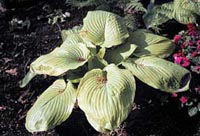Resource Library
Plant of the Week: Hosta
The University of Arkansas System Division of Agriculture does not promote, support or recommend plants featured in "Plant of the Week." Please consult your local Extension office for plants suitable for your region.
Plant of the Week
Hosta

July heat is upon us, and for the next couple of months gardening will become a spectator sport. We may cuss the shade in May because it limits the choice of plants we can grow, but come high summer, all hostility melts away as the temperatures steadily climb. During the last two decades, hostas have become one of the staples for the shade garden. And of the thousands of hostas available, Sum and Substance is one of the most impressive.
As the commercial proclaims, size matters. This is one impressively large hosta with clumps reaching 5-6 feet across with leaves the size of a turkey platter. Plants require a couple years to get established and attain this impressive stature.
The leaf color of Sum and Substance is a medium yellow-green with no variegation. The foliage is about 2-feet tall with flower spikes extending 18 inches above the leaves when blooms appear in mid-summer. The funnel-shaped white flowers are 2-inches across and lack any discernable fragrance.
Northern hosta growers refer to Sum and Substance as a golden-leafed hosta because it’s able to grow in more sun. In a sunny site in the North, the foliage will take on a golden glow, but in the South it takes on the look and feel of toast if it's planted in too much sunlight. For us, the foliage is more chartreuse than gold.
A good compromise in the South is a location that receives full sun in the morning but shade from noon onward.
Sum and Substance was one of the hybrid hostas developed by Paul Aden of Baldwin, NY. Since beginning his breeding career in the late 1960s, Aden has registered more hosta cultivars than any other American breeder. He released his first four cultivars in 1974 and his second release in 1978 when he named and released 40 introductions. From this batch of plants, Sum and Substance and the yellow variegated selection Wide Brim were two of the most outstanding introductions.
The growth in popularity of hostas in American gardens can be attributed to several factors, but the most important is its toughness. It is one tough customer. Unlike many perennials that take constant care and attention, hostas will remain with you if you lavish them with attention or ignore them completely.
Because this is a large hosta best suited for specimen use, it should not be crowded in the bed. Plant the plants at least 5 feet apart if you want them to be viewed as individuals, not as one large clump. A grouping of three plants together in a significant location in the garden can’t help but call attention to the site. They can also be used along a garden path to give an almost tropical feel with their large, luxuriant leaves.
Hostas perform best in a fertile garden soil that doesn’t stay too wet during the winter, but they are remarkably tolerant of less than perfect conditions. I have some hostas growing in heavy clay subsoil where almost any self-respecting perennial would have died long ago. As I said, hostas are tough.
I fertilize my plants with a liberal sprinkling of complete fertilizer every spring just as the new shoots emerge from the crown. Plants can be divided after five years, but undivided plants usually give the best display.
By: Gerald Klingaman, retired
Extension Horticulturist - Ornamentals
Extension News - July 12, 2001
The University of Arkansas System Division of Agriculture does not maintain lists of retail outlets where these plants can be purchased. Please check your local nursery or other retail outlets to ask about the availability of these plants for your growing area.